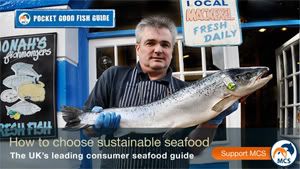Buying seafood sustainably, though, is quite tricky - even for the most attentive and well-meaning of us. Shops tend to only display the price and the name of the fish, which can be known by several different names locally. It's hard to know what the actual fish you're buying is, and where it came from. For example: if you bought rock salmon, you wouldn't think you were buying an endangered species of shark, but you might be.
Thankfully, FishOnline makes it a little easier for us. Set up by the Marine Conservation Society (MCS) in the United Kingdom, FishOnline has many tools users can take advantage of to gauge whether the fish you're buying is sustainable or not. Users can enter the name of any fish into the Search field and pull up either simple results overviewing the species or advanced information such as stock health and method of capture. This site was designed with UK shoppers in mind, but recognizing that many species are fished in one part of the world and sold in others, the information here can be used by pretty much anyone. I have found it just as helpful when shopping in the US.

image credit MCS
Another notable tool is the Fish Purchasing Guide under the "Buying & Eating" tab. This displays a year-long calendar illustrating the best times to buy and to avoid buying your favorite fish, taking seasonal spawning into account. Below the calendar is a chart with more information about where the fish are sourced from, minimum landing size, and the best possible choice when it comes to making a purchase.
But don't worry, if that's too confusing for you to follow, FishOnline has prepared two simple lists of Fish to Avoid, and Fish to Eat! They even have a handy print-out Pocket Good Fish Guide to take with you on your next grocery trip! It fits right in your wallet, and the key is simple; fishes marked in green are the best choices, fishes marked in yellow are at risk of becoming unsustainable and should be bought with caution, and those marked in red are fish to avoid from unsustainable and overfished species.
Super helpful, super easy. So grab your reusable shopping bags, print yourself a Pocket Good Fish Guide, and get some fish at your favorite local or sustainable market tonight! yum!
More info here:
MCS
FishOnline
No comments:
Post a Comment